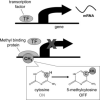Nutrigenomics and metabolomics will change clinical nutrition and public health practice: insights from studies on dietary requirements for choline
- PMID: 17823415
- PMCID: PMC2430757
- DOI: 10.1093/ajcn/86.3.542
Nutrigenomics and metabolomics will change clinical nutrition and public health practice: insights from studies on dietary requirements for choline
Abstract
Science is beginning to understand how genetic variation and epigenetic events alter requirements for, and responses to, nutrients (nutrigenomics). At the same time, methods for profiling almost all of the products of metabolism in a single sample of blood or urine are being developed (metabolomics). Relations between diet and nutrigenomic and metabolomic profiles and between those profiles and health have become important components of research that could change clinical practice in nutrition. Most nutrition studies assume that all persons have average dietary requirements, and the studies often do not plan for a large subset of subjects who differ in requirements for a nutrient. Large variances in responses that occur when such a population exists can result in statistical analyses that argue for a null effect. If nutrition studies could better identify responders and differentiate them from nonresponders on the basis of nutrigenomic or metabolomic profiles, the sensitivity to detect differences between groups could be greatly increased, and the resulting dietary recommendations could be appropriately targeted. It is not certain that nutrition will be the clinical specialty primarily responsible for nutrigenomics or metabolomics, because other disciplines currently dominate the development of portions of these fields. However, nutrition scientists' depth of understanding of human metabolism can be used to establish a role in the research and clinical programs that will arise from nutrigenomic and metabolomic profiling. Investments made today in training programs and in research methods could ensure a new foundation for clinical nutrition in the future.
Figures


References
-
- Lane MA, Bailey SJ. Role of retinoid signalling in the adult brain. Prog Neurobiol. 2005;75:275–93. - PubMed
-
- Hsu SC, Huang CJ. Reduced fat mass in rats fed a high oleic acid-rich safflower oil diet is associated with changes in expression of hepatic PPARα and adipose SREBP-1c-regulated genes. J Nutr. 2006;136:1779–85. - PubMed
-
- Muller M, Kersten S. Nutrigenomics: goals and strategies. Nat Rev Genet. 2003;4:315–22. - PubMed
-
- Fuks F. DNA methylation and histone modifications: teaming up to silence genes. Curr Opin Genet Dev. 2005;15:490–5. - PubMed
-
- Holliday R, Grigg GW. DNA methylation and mutation. Mutat Res. 1993;285:61–7. - PubMed
Publication types
MeSH terms
Substances
Grants and funding
LinkOut - more resources
Full Text Sources

